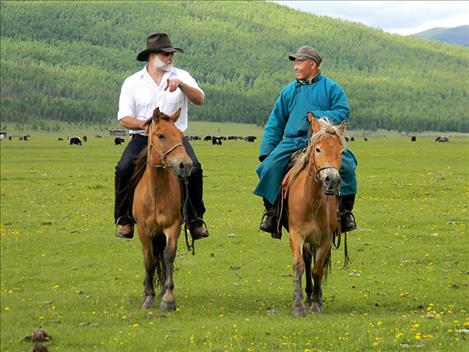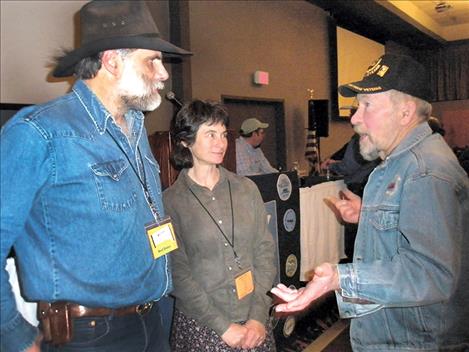Local couple details trip to Mongolia, land of Eternal Blue Sky
Hey savvy news reader! Thanks for choosing local.
You are now reading
2 of 3 free articles.
They weren’t just “horsing around,” they also got to experience a new culture.
Columbia Falls residents Greg and Deb Schatz presented details of their trip to Mongolia on Friday at KwaTaq- Nuk Resort as part of the Montana Back Country Horsemen convention.
Greg said Mongolia was the only foreign country the couple wanted to visit. That’s because of their love of horses.
“The horse packing in Montana came from Mongolia,” he said, explaining that it came through the Spaniards who traveled up from Mexico.
The Schatzs visited the Darhad Valley in the Mongolian state of Khuvsgol Aimig for three weeks last summer.
It was the only the third time the couple had flown on an airplane since they married in 1988 and moved to the Flathead in 1989. They flew from Kalispell to Seattle on Alaska Airlines and then on Korean Air to Seoul and Ulaanbaater, the capital of Mongolia, which became a democracy in 1990.
Greg feels like he has a connection with the herders in the Darhad Valley. The steppes there are similar to those not far away in Russia where his great-grandparents on both sides of his family came from, he said.
The deep-fat fried doughnuts the Mongolian herders eat with just about every meal also remind him of what his ancestors ate, he said.
The Schatzs were part of 30 people who took the trip to ride horses alongside the herders. The trip was sponsored by the non-profit Bioregions International of Bozeman. Others who went were six Native American students from Montana State University, a medical team of five and a soils team of four, among others.
The Schatzs explained to the herders how they take different kinds of outfitter trips with members of the public into the Montana backcountry, including the “Leave No Trace” theme.
The culture of the Mongolian herders is such that they have “zero materialistic values,” Greg said. They live in little cabins, and while they are herding away from home they will sleep on the permafrost or in a 30-foot-diameter ger or yurt.
Deb said her most memorable part of the trip was “how they respect the land and how everything is sacred.” Typical herder religions range from shamanism to Buddhism to what Greg calls “naturalist.” which includes a respect for “Mother Earth” and “Father Sky.”
The herders do not dig the soil or cut the grass out of respect for the earth, so no gardens are grown. Ovoos, which consist of piles of stones or tree branches, are built on hills or mountains. Horse skulls and other objects such as khadag, or blue scarves, which represent the Eternal Blue Sky, are hung from them. Such offerings are made when one comes across an ovoo and circles it three times clockwise.
The herders will often tie or hobble their horses to their own legs or to another horse to prevent them from wandering off during stops if no post is nearby.
The typical horse lives to age 20 and is then “put down” and eaten by the herders. This is a form of respect, Greg said.
The herders raise horses, cows, Cashmere goats, sheep and yaks. The yaks are raised for their meat and milk, which is used to make cheese and yogurt, while sheep are raised for meat and fur. Reindeer live to the north of where the Schatzs visited, although they saw two on their trip.
Cottonwood trees grow near the riverbanks in the land of Genghis Khan with Siberian larch in the foothills and spruce and fir in the mountains, which Greg described as similar to Montana.
He noted that some 8.3 million acres have been set aside in Khuvsgol Aimig for state and national parks.
The Schatzs plan to return to Mongolia in the summer of 2018.

















